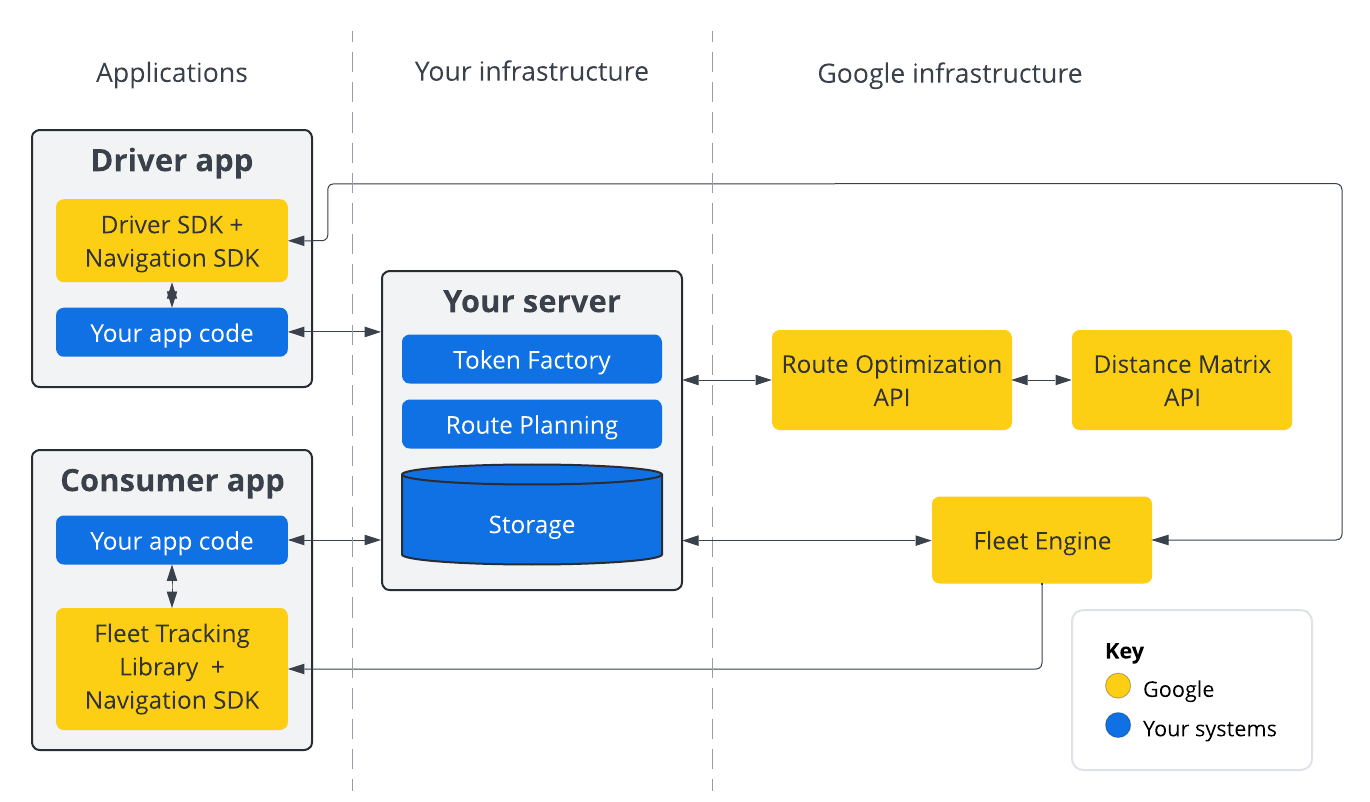本文档概述了如何使用以下两款产品为日常送货业务执行整个车队的路线优化:
- Fleet Engine
- Route Optimization API (GMPRO)
Fleet Engine 本身可以使用您提供给 Fleet Engine 后端的路线规划,从任何路线求解器获取输入。不过,如果您没有自己的路线求解器,或者有兴趣探索其他路线解决方案,则可以将 Route Optimization API 与 Fleet Engine 搭配使用,以便全天持续优化路线。
简介
在日常配送运营中,您的车队解决方案通常会使用 Fleet Engine 服务来执行以下路线优化工作流:
- 初始路线规划 - 使用路线求解器定义每日路线规划,并将其输入到 Fleet Engine 中,以便司机查看、执行和跟踪。
- 重新优化 - 在一天中的中间时段选择特定路线,以应对路线变化(例如交通问题或时间窗口变化),并重新优化以提供更顺畅的司机和客户体验。
- 新经停点分配 - 在现有路线中分配新经停点,例如临时上车请求。
Route Optimization API 和 Fleet Engine 结合使用,可提供规划和跟踪功能,从而实现这一目标。
Route Optimization API
Google Maps Platform 路线优化 API (GMPRO) 可满足复杂的车辆路线规划需求。例如,您可以制定送货和送货车辆计划,同时应用取货时间和包裹重量等限制条件。GMPRO 可以异步或近乎实时地创建路线规划,具体取决于路线规划中的车辆数量。如需详细了解路线优化,请参阅 Route Optimization API 文档。
Fleet Engine
Fleet Engine 是移动服务的一部分。借助 Fleet Engine,您可以对车队进行建模、规划司机活动,并在司机递送包裹时实时跟踪包裹。对车队进行建模涉及定义车辆、任务、停靠点和路线段。
系统组件
下图描述了您自己的系统如何集成 Fleet Engine、Mobility 服务 API 和路线优化 API,以构建可增强和优化规划及日常车队运营的系统。在此图表中,GMPRO 使用 Google 地图距离矩阵服务和数据来解决问题,但您的集成也可以使用其他提供商。

在车队管理系统中,每个组件都有特定的用途:
- 您的司机应用 - 您可以使用 Driver SDK 和 Navigation SDK 为司机创建 iOS 和 Android 移动应用。借助 Driver SDK,您可以实时更新送货信息、车辆位置和订单状态,并在应用中显示这些信息。如需了解按需行程,请参阅 Driver SDK 用户指南(Android、iOS)。请参阅 Navigation SDK 文档。
- 您的运营 - 您可以创建使用 Google Fleet Tracking Library 构建的网络信息中心,以显示所有车辆的实时数据。借助此功能,您可以编排和监控舰队。
- 您的系统 - 后端服务和数据库可确保您的业务安全地日常运营。
- Google 系统 - Route Optimization API 使用 Distance Matrix API 查找多个位置之间的行驶距离和时间。
后续步骤
如果您有兴趣了解如何将 Fleet Engine 与路线优化 API 集成,请参阅以下内容:

